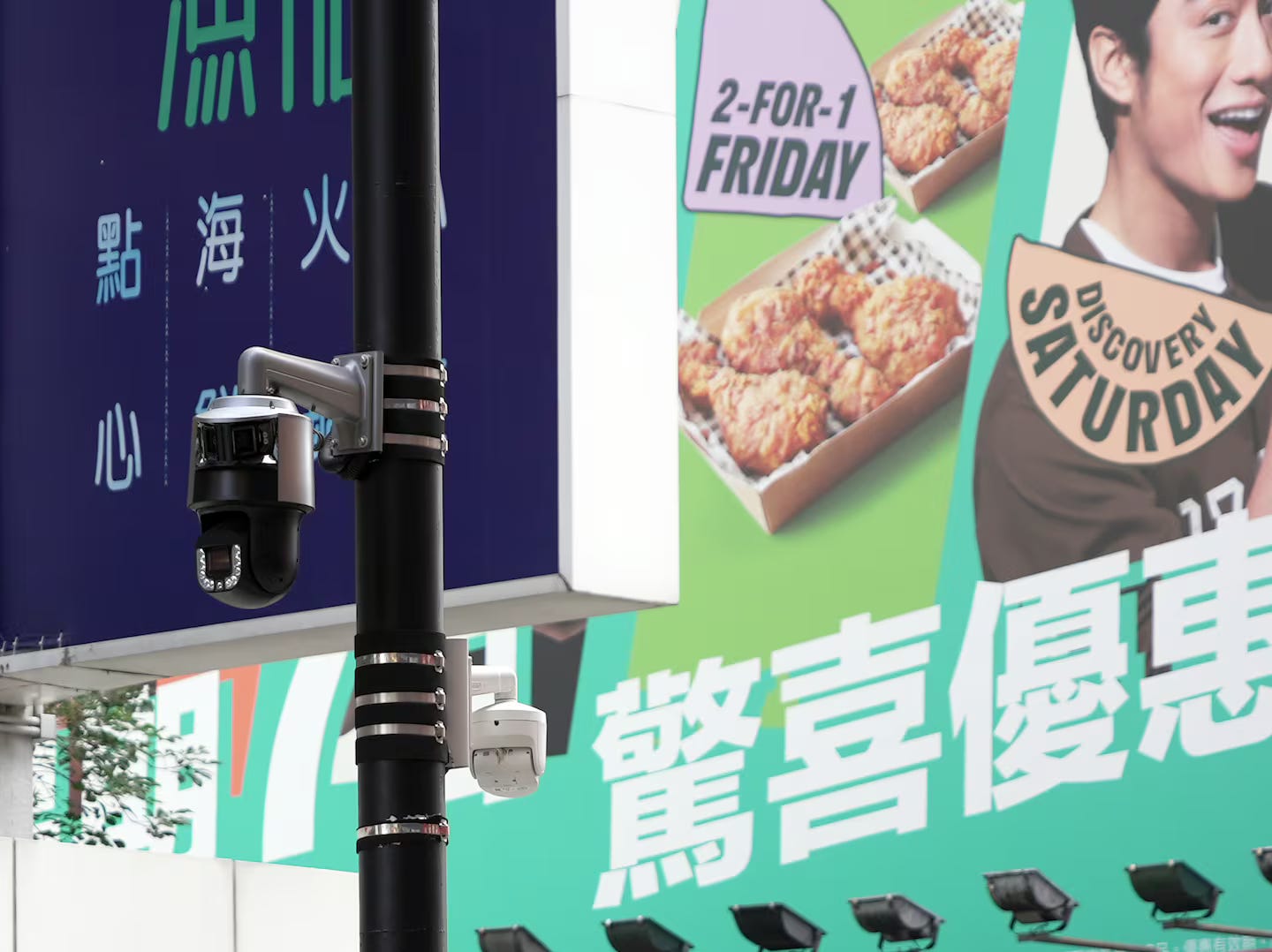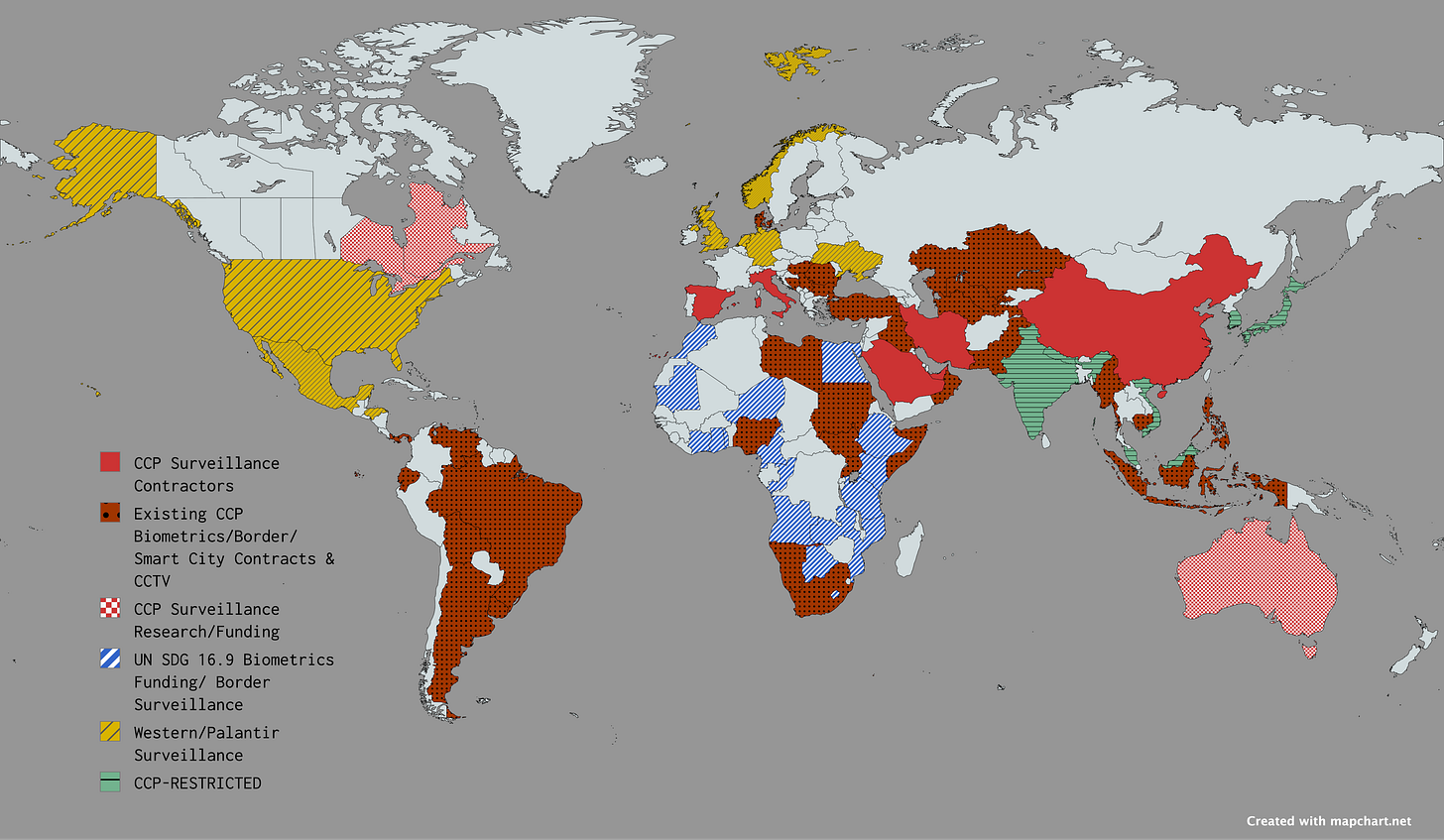CCP "Sharp Eyes/SmartView" Smart City Surveillance Expands To Hong Kong, Spain, Italy & Iran With Research From Canadian Universities
Thermal, voiceprint, AI surveillance brought to you by Qualcomm, iFlytek, DeepSeek, Sensetime, York and Queens University and more. Could this be an attempted expansion of the Great Firewall?
Last Sunday, the last pro-democracy party in Hong Kong, the League of Social Democrats, disbanded, along with other crucial civil society organizations amongst a wave of new disappearances under the city’s new National Security law. Under the law, police have arrested around 330 individuals, prosecuted 189, and secured convictions against 165 under opaque justification.
Privacy and civil liberties are taking a massive hit as well as China’s policing surveillance dragnet expands to the shores of Europe, Iran, and Hong Kong. iFlyTek is funding research from York and Queen’s universities in Canada, while Hikvision, ZTE, Huawei, Tiandy provide CCTV backbones. iFlyTek voice pattern recognition, national biometrics databases, AI pattern detection models can retroactively track movement on a persistent basis.
The Chinese government has been investing heavily in AI-driven biometric data capturing over the past decade. Facial recognition, thermal cameras, AI object and movement detection, and surveillance technologies such as "smart cities," integrate into the CCP’s Sharp Eyes program, which can monitor all aspects of an individual's public life are all on the docket, according to Wenhao Ma of VOA’s China Division. Hong Kong authorities used evidence from AI surveillance cameras installed last year to prosecute six people for monkey feeding, while using thermal cameras and AI data aggregation to target rat populations.
The police force is considering gaining access to video surveillance feeds from the Leisure and Cultural Services Department, the Transport Department, and the Housing Department, as well as the MTR Corporation (MTRC) within the year, local media reported, citing unnamed sources. The SmartView programme is an initiative, implemented by the police in collaboration with government departments, to install closed-circuit televisions (CCTVs) in public places with high crime rates and pedestrian flow to prevent and help fight crime.
This however, has had impacts on local behaviour, just as it had in Xinjiang, just as it will have in other surveillance states. 2021 electoral reforms required any important positions of governments to be CCP loyalists. Hong Kong's government said: "The improved legislative coalition is now rid of extremists who wish to obstruct and even paralyse the operation of the government without any intention of entering into constructive dialogue to represent the interests of all Hong Kong people."
The number of large-scale protests has dwindled to none at all.
In academia, fear of surveillance - and how life might change for someone who infringes the laws - means self-censorship and censorship have become the "order of the day"
-BBC
Residents avoid discussing politics publicly or on digital platforms, fearing state monitoring. Reduction in online activity is occurring on platforms perceived as insecure, such as Facebook or WhatsApp. Widespread fear of informants, undercover officers, or digital infiltration is rampant, reminiscent of the Soviet Union. Activist groups become more insular, compartmentalized, with limited information sharing
huawei.com: The Hong Kong government has published Smart City Blueprint 2.0, which provides a roadmap for smart city development based on six pillars: Smart Mobility, Smart Living, Smart Environment, Smart People, Smart Government and Smart Economy. All these pillars are crucial for the citizens and the development of Hong Kong. The Hong Kong government established the Digital Economy Development Committee to accelerate progress towards these goals and the digital economy. With the 5G technology, HKT is well-positioned to offer enterprises innovative solutions for achieving digital transformation. 5G is a super enabler for innovation, that provides high bandwidth, low latency and massive connectivity, which can help enterprises make breakthroughs in their operation. In Hong Kong, many enterprises are exploring ways to leverage the integration of different technologies, including 5G, AI and cloud computing to drive digital transformation.
While Smart Cities promise convenience and safety, their embedded surveillance architectures threaten privacy, civil liberties, and freedom of thought. Left unchecked, they risk transforming open societies into digital panopticons, where behavior is engineered through constant observation and fear of reprisal.
Starting in crime hotspots, authorities will allegedly integrate existing surveillance systems from public housing estates and MTR (mass transit railway) stations to the State Security’s police network.
According to Hong Kong’s Secretary for Security Chris Tang Ping-keung, Hong Kong will expand its police CCTV network by adding 5,000 to 7,000 cameras each year over the next two years, with plans to integrate facial recognition, drones, and other AI technologies to enhance crime detection.
By 2027, an additional 7,000 cameras will be installed. The Hong Kong Police are planning to connect the city’s MTR cameras to “Sharp Eyes” while expanding the CCTV network. The police aim to connect the systems of the Transport Department, the Leisure and Cultural Services Department, the Housing Department and MTR to Sharp Eyes in phases this year.
The Sharp Eyes surveillance project initiated from Beijing in the late 2010s with the aim of surveilling all public space in China. The plan, which was outlined in the 13th Five Year Plan released in 2016, seeks to computerize surveillance and has been a launchpad for Chinese companies that sell facial recognition technology.
This would bring over 20,000 cameras into the network. These departments say their systems currently lack facial recognition capabilities, according to Hong Kong 01. This is only a matter of time and investment.
Authorities in Hong Kong have also turned to hi-tech surveillance techniques to track rat activity – a method said to be more accurate than the former approach of using sweet potato as bait.
Authorities have deployed thermal cameras and AI image recognition technology to more accurately measure the rodent problem across Hong Kong. By counting the number of thermal images with no rodents among all images taken, a rodent absence rate is generated for each area. Among the 200-300 areas monitored, pest control can come in at night having clearer datasets of rat population movements. This is just another example of how multiple surveillance technologies can appear inside one camera casing, such as gait detection lasers inside London’s Siemens ULEZ system.
Chinese biometrics firms, such as Hikvision, SenseTime, and Dahua, have increasingly set up operations in Hong Kong to leverage its status as a global financial hub and a gateway to international markets. A March 2025 report from Biometric Update noted that these companies are using Hong Kong’s relaxed regulatory environment and strategic location to bypass Western sanctions and access global markets.
BiometricUpdate: Voice recognition company iFlytek decided to set up global headquarters in Hong Kong in July last year, facial recognition firm CloudWalk has also shared intentions to establish an entity in the city.
In January, the U.S. Department of Defense added several Chinese tech companies, including SenseTime and CloudWalk, to its Chinese Military Companies List (CMC List). iFlytek was placed on a U.S. trade blacklist in 2019 for aiding the Chinese government in the mass surveillance of the Uyghur population. But this hasn’t stopped the firms from entering other foreign markets.
Earlier this month, iFlytek said it’s planning to expand its European business. The Anhui-based firm currently sells in France and Hungary, Vice President Vincent Zhan said during the Mobile World Congress in Barcelona.
“For next year, we have a plan to expand to more countries in Europe, such as Spain and Italy,” says Zhan.
CloudWalk, on the other hand, has been supplying its technology to Zimbabwe since 2018.
Chinese surveillance equipment manufacturer and Intel subsidiary Tiandy is known to have sold products to the Iranian military through its Iranian subsidiary. The firm has recently been blacklisted in the U.S. partly for this, as equipment contains U.S.-origin items whose export to Iran are banned, and partly for its involvement in repression of minority groups in China including Uyghurs.
According to The Globe and Mail, iFlytek gave York University $1.5 million (US$1.24 million) in 2015 for the creation of the iFlytek Laboratory for Neural Computing and Machine Learning. For the grant, the biometrics firm also was given a chair at the Lassonde School of Engineering.
One professor at the laboratory allegedly works with China’s National University of Defence Technology.
In January, Canadian cybersecurity firm Feroot Security uncovered a code imbedded in DeepSeek’s login processes that shares user information with Chinese state-owned communication company China Mobile, AP reported.
The Associated Press described the code as a “heavily obfuscated computer script that when deciphered shows connections to computer infrastructure owned by China Mobile.”
The U.S. banned China Mobile in 2019 following intelligence reports that it serves as the Chinese military’s spy arm.
A March 2025 Voice of America report revealed that DeepSeek is being used by Chinese security services for biometric data collection, social media monitoring, and disinformation campaigns targeting the U.S.. The model’s ability to analyze massive datasets in real-time makes it a formidable tool for identifying vulnerabilities in global systems, from critical infrastructure to personal data.
The Shenzhen-based company ZTE has been active in Iran since 1382 (2003), Rooznameh Rasmi documents show.
Most recently, the U.S. Commerce Department accused ZTE of using Far East Cable Factory as a middleman to sell products to Iran, according to reports by Reuters and the Wall Street Journal. Far East Cable Factory has been present in Iran since 1388 (2010), according to Rooznameh Rasmi documents.
Hikvision has been active in Iran since 2008, according to a Rooznameh Rasmi registration document, and was active through 2021.
According to MIT Technology Review, the company’s products include police surveillance systems as well as baby monitors, and are available in more than 190 countries. Hikvision is part of the backbone of Xinjiang surveillance. Huawei continues its “donations” of surveillance cameras to South American countries while the UN funds national biometrics in Africa, competing with proliferating Huawei, Alibaba, Tencent 5G and computing/storage infrastructure across the Middle East, South America, and Africa.
The global proliferation of Chinese AI surveillance technologies poses profound challenges to civil liberties. In Hong Kong, the use of facial and voice recognition to monitor and suppress dissent has eroded freedoms once protected under the city’s semi-autonomous status. The National Security Law, coupled with AI-driven surveillance, has created a climate of fear, where individuals self-censor to avoid arbitrary detention. This model of control is being exported to countries like Iran, where biometric surveillance is used to enforce social norms and silence opposition, undermining fundamental human rights.
In democratic nations like Italy and Spain, the adoption of Chinese surveillance technologies risks normalizing invasive monitoring practices. Even with regulatory safeguards, the integration of these systems into public infrastructure—airports, smart cities, and law enforcement—raises concerns about data misuse and potential backdoors for foreign access. As always, decentralization and privacy of the end user will always be recommended here for maintaining wider security.









